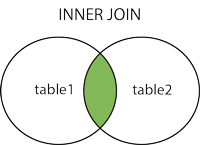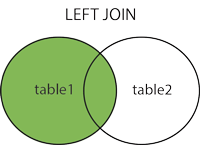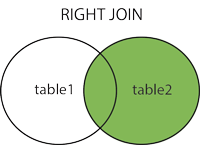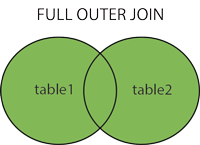
MaxBeauchemin
8/7/2018 - 8:30 PM
SQL Joins
Shows the basic concepts of SQL joins
First, let's setup some sample data so we can look at how it relates
Customers Table
| CustomerId | Name | |
|---|---|---|
| 1 | Joe Cool | TheCoolest@aol.com |
| 2 | Steven Brave | TheBravest@yahoo.com |
| 3 | Devin Smart | 314159@wi.rr.com |
Orders Table
| OrderId | CustomerId |
|---|---|
| 1 | 1 |
| 2 | 1 |
| 3 | 2 |
Items Table
| ItemId | Description |
|---|---|
| 1 | Baseball Gloves |
| 2 | Football Cleats |
| 3 | Soccer Ball |
Order Items Table
| OrderItemId | OrderId | ItemId | Quantity |
|---|---|---|---|
| 1 | 1 | 1 | 1 |
| 2 | 2 | 2 | 1 |
| 3 | 2 | 3 | 2 |
| 4 | 3 | 3 | 1 |
Now we can start talking about Joins
For all joins, we are matching up different tables based on some criteria. Typically, this will be done with a foreign key, meaning these officially related in some way, but the way we join tables is using the ON keyword, which allows us to define a condition which will tell us whether the two records in question should be matched or not.
Inner Joins

Inner Joins are for matching up records between two tables and only keeping things that have a match.
Consider the following, if we are looking at the Order Items table, we may want to be able to see the Descriptions of the Items rather than just their Ids
To do so, we could do the following:
SELECT oi.OrderItemId, oi.OrderId, oi.ItemId, i.Description, oi.Quantity
FROM OrderItems oi
INNER JOIN Items i
ON oi.ItemId = i.ItemId
This gives us the following:
| OrderItemId | OrderId | ItemId | Description | Quantity |
|---|---|---|---|---|
| 1 | 1 | 1 | Baseball Gloves | 1 |
| 2 | 2 | 2 | Football Cleats | 1 |
| 3 | 2 | 3 | Soccer Ball | 2 |
| 4 | 3 | 3 | Soccer Ball | 1 |
If we wanted to get a full snapshot of information, we can also remove the ID columns and join multiple layers down
SELECT c.Name, i.Description, oi.Quantity
FROM Customers c
INNER JOIN Orders o
ON o.CustomerId = c.CustomerId
INNER JOIN OrderItems oi
ON oi.OrderId = o.OrderId
INNER JOIN Items i
ON i.ItemId = oi.ItemId
This query would give us the following result:
| Name | Description | Quantity |
|---|---|---|
| Joe Cool | Baseball Gloves | 1 |
| Joe Cool | Football Cleats | 1 |
| Joe Cool | Soccer Ball | 2 |
| Steven Brave | Soccer Ball | 1 |
When dealing with Inner Joins, it is very easy to hide rows because they do not have a matching record in the table being joined on.
Consider the following query, where we want a list of Customers:
SELECT c.CustomerId, c.Name, c.Email
FROM Customers c
This just gives us the raw Customers table
| CustomerId | Name | |
|---|---|---|
| 1 | Joe Cool | TheCoolest@aol.com |
| 2 | Steven Brave | TheBravest@yahoo.com |
| 3 | Devin Smart | 314159@wi.rr.com |
But if we wanted to also get information about the Orders they have placed, we could do the following
SELECT c.CustomerId, c.Name, c.Email, o.OrderId
FROM Customers c
INNER JOIN Orders o
ON o.CustomerId = c.CustomerId
Which gives us the following:
| CustomerId | Name | OrderId | |
|---|---|---|---|
| 1 | Joe Cool | TheCoolest@aol.com | 1 |
| 1 | Joe Cool | TheCoolest@aol.com | 2 |
| 2 | Steven Brave | TheBravest@yahoo.com | 3 |
Notice how Devin Smart was removed from the result because he has not placed any orders, but what if we still want him to show up in the list?
Then we can do a Left Join
Left Joins

Left Joins allow you to grab data from a single table, and then add additional data by joining to another table, without worrying about hiding records because they do not have a match.
Consider the last example in the Inner Join section. We wanted to include Devin Smart in the list, even if he did not have any Orders places.
Let's look at how we'd do that with the help of a Left Join
SELECT c.CustomerId, c.Name, c.Email, o.OrderId
FROM Customers c
LEFT JOIN Orders o
ON o.CustomerId = c.CustomerId
If you look closely at the query above, you'll notice the only difference was changing the type of join
Now our result is the following:
| CustomerId | Name | OrderId | |
|---|---|---|---|
| 1 | Joe Cool | TheCoolest@aol.com | 1 |
| 1 | Joe Cool | TheCoolest@aol.com | 2 |
| 2 | Steven Brave | TheBravest@yahoo.com | 3 |
| 3 | Devin Smart | 314159@wi.rr.com | NULL |
We now have an extra record in our result, but we can notice that the OrderId field is NULL, which is because we were unable to match the Customer with any Orders. You should be very careful when using Left Joins as they can have a lot of NULL fields due to their nature.
Right Joins and Outer Joins
We won't really be talking about these, but we can include the following diagrams for reference

